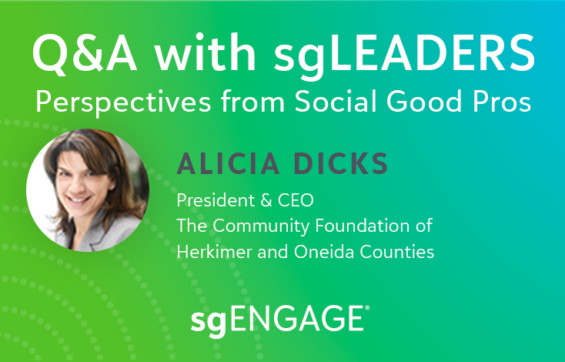Q&A with sgLEADERS: Alicia Dicks, The Community Foundation of Herkimer and Oneida Counties

The “Q&A with sgLEADERS” series on sgENGAGE aims to provide readers, including the next generation of social good leaders, with valuable insights from executives across the social good community.
Today’s Q&A is with Alicia Dicks, President & CEO of The Community Foundation of Herkimer and Oneida Counties. In her role, Alicia is responsible for leading and inspiring staff, Trustees and partners to create opportunities and innovative solutions to community challenges.
Q: What led you to working at a community foundation?
A: To be honest, I was resistant to working for an organization that I had considered unapproachable and to a degree, exclusive. But the potential impact this organization could have on the community was enormous, and the board wanted to change the organization from grant maker to impact investor. Over the past six years we have, and continue to, transform the organization to be a trusted partner and community stakeholder, addressing many critical community priorities.
Q: The Community Foundation of Herkimer and Oneida Counties and the United Way of the Valley and Greater Utica Area led a joint Mohawk Valley COVID-19 Response Fund. Can you talk about how you were able to pivot the Foundation’s focus to meet the immediate and ongoing needs of local organizations due to the pandemic while also maintaining a focus on your longer-term goals and mission?
A: The reprioritization to meet partner needs due to COVID-19 was a test of our adaptability, a major component of our cultural ethos. We were able to quickly develop a partnership with United Way, engage with our donors, and get the process for the joint response fund up and running in a timely and efficient manner. Many of our pre-pandemic initiative goals either slowed, postponing timelines, but more important, were thoughtfully enhanced. As we shifted our focus and resources, we took time to learn from the impacts of COVID-19, especially its effects on underserved and vulnerable populations, and were able to adapt our strategic work and goals accordingly. In the Fall of 2020, when COVID-19-related needs had leveled off to some degree, we used an extraordinary funding rounding (after a pandemic-caused moratorium) to assess needs, further adapting our approach. Our major “pivot” has been to articulate a new focus on racial equity and social justice, transitioning community investment strategies and prioritizing them through an equity lens. We are redesigning our 2021 strategy as we continue to listen to, and learn from, our community partners.
Q: You recently announced a new 10-year, $10 million commitment to fight for racial equity and social justice locally. What was your strategy for getting all the different stakeholders aligned on this big initiative? Did you face any major obstacles, and if so, how did you overcome them?
A: Our July announcement to make a 10/10 initial commitment to racial equity and social justice was a direct outcome of the renewed focus on these issues following the deaths of George Floyd and others, and the ensuing protests and calls for fundamental societal change. Our board, after much discussion, unanimously set the stage for us to redirect our work and tackle many longstanding complex social issues. The work to build partnerships, stakeholders and, ultimately, greater community trust has just begun. Early progress is encouraging: We have established an Equity Advisory Group to help lead this work in all it is forms, as well as a Black Leadership Coalition; we are also exploring Diversity, Equity, Inclusion collaboration among community partners. Related to the community DEI collaboration, we are also working from the inside out–engaging in multi-month DICE (Diversity Inclusion Community Equity) education process for our staff, board, and critical partners so that we are better equipped to take on this role in a meaningful way. Having already embarked on a resident engagement strategy, we will also listen and learn from diverse community inform our process—and proactively and thoughtfully address concerns and inevitable criticisms. We set out knowing that we may face discontent from a few, but are committed to engaging our whole community and moving forward with a meaningful strategy.
Q: What accomplishment are you most proud of as the President & CEO of The Community Foundation of Herkimer & Oneida Counties?
A: There are many, but first and foremost, I am MOST proud of building a talented team committed to the ever-changing challenges in this work. As far as accomplishments, I am proud that our board is willing to take risks on behalf of our community needs unconventional to our model, such as allocating money from our endowment to tackle the Childhood Lead Poisoning crisis in our community.
Q: What role does technology play in your organization, and how do you see it continuing to have an impact in the future?
A: Technology, and the data-to-decision model we are trying to build, are essential to our success. We have spent an enormous amount of time and talent to optimize the technologies we use and get our systems to work for us. Our aspiration is to have quality, analytical tools to help us assess needs, priorities and determine solution-based investments that support the nonprofit partners in our area. We have made the transition in this new virtual environment with few pain points. Our team utilizes many connectivity platforms to stay connected and advance our mission. In many ways, we have found that we are more productive, with a few exceptions. This ease of virtual working was a direct result of investments we recently made to move our data to the cloud, and our focus on upgrading our systems. If we had not made that investment, we would have had greater challenges to overcome during the pandemic crisis.
Q: What is the best piece of advice you have received that has guided the way you lead?
A: I have two that have been relevant in our organization: “Listen, Learn and Adapt” — change is constant, we need to remain nimble. “Remain as flat an organization as possible” – allow your team/talent to innovate and succeed with a culture of care, concern and guidance.
Q: What are you reading right now and/or what podcast are you listening to?
A: Unicorns Unite: How nonprofits and foundations can build EPIC Partnerships and “Moving to Action on Racial Equity, Inclusion, and Diversity: Insights from Philanthropic Leaders at SOCAP18“
Read more about how The Community Foundation of Herkimer and Oneida Counties is having an impact.
